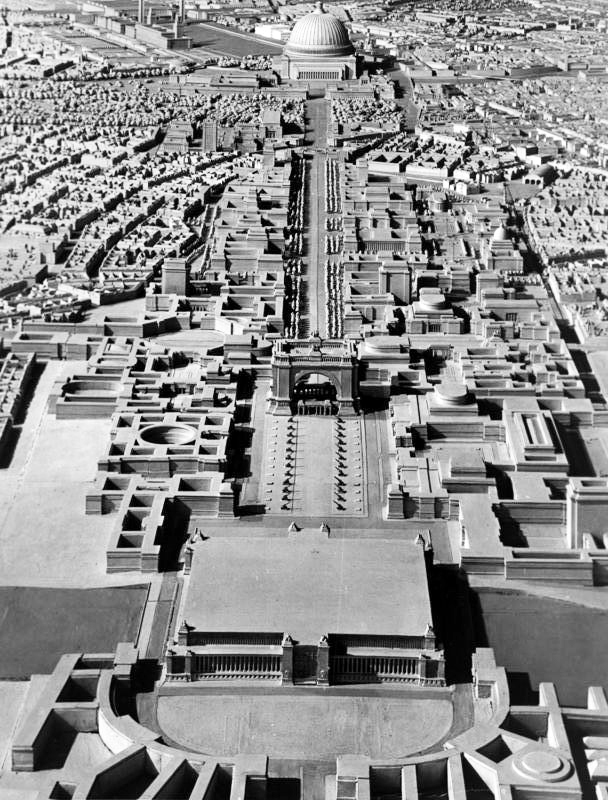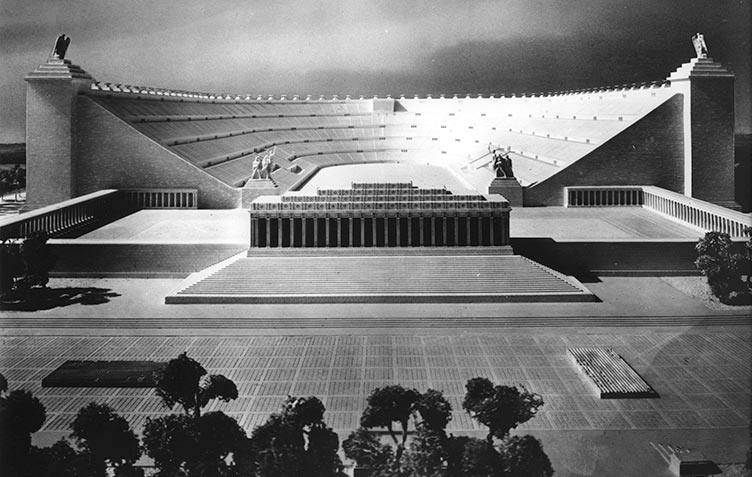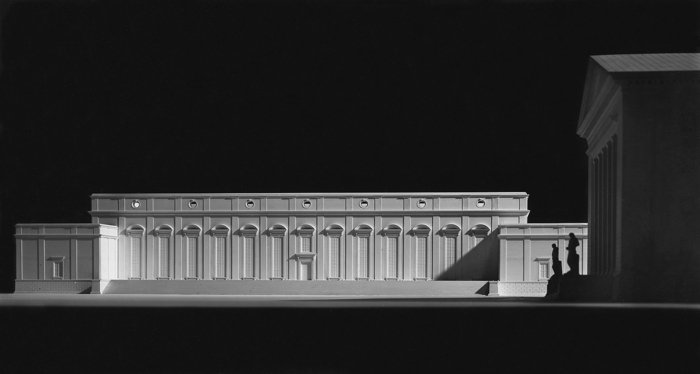It is no secret that Adolf Hitler had great, megalomaniacal plans for Germany after the long sought-after victory in World War II. While his plan for reconstructing Berlin and turning it into the new military and cultural capital of the world is well known, less talked about are the actual details of the plan, and his plans for other cities such as Nuremberg, and Linz. This article will go over the details of the Nazi plan for Berlin, and the unbuilt monstrosities that would have dominated Germany and Austria’s cities.

Berlin
After World War II, Berlin was to be the Welthaupstadt, the World Capital of Germania, with the project being overseen by Hitler’s chief architect, Albert Speer. It was Hitler’s wish for Germania to be comparable only to Ancient Rome and Babylon, with modern cities such as London and Paris being eclipsed. By far the most striking feature of the city was the three-mile long boulevard that the city would be based around, dubbed the “Avenue of Splendors.” The avenue would have connected a gargantuan triumphal arch that would be able to fit the Arc de Triomphe within it, which would then lead to the Greater Plaza, where the crown jewel of Germania, the Volkshalle would be. The Volkshalle would have been the largest domed structure ever built, and would have been completely made from granite. Within it, rallies and speeches would be held to an audience of 180,000. The building would have been so large, one could lower the dome of St. Peter’s Basilica through it, and it would have been able to produce its own rain from the condensation from people’s breaths.

Alongside the Volkshalle in the Greater Plaza would have been Hitler’s palace, the old Reichstag building, and other Nazi government buildings.

Ironically, Germania took direct inspiration from Paris. The Avenue of Splendors would have been used solely for parades, similar to how Napoleon III envisioned the boulevards of Paris being used, and like Paris, the boulevard would be centered around a triumphal arch. However, unlike Paris, foot traffic and car traffic would have been concentrated underground, leaving the streets devoid of life apart from military displays, reinforcing the image of the state as the end-all-be-all. Another example of this was a giant reflecting pool that would have been outside the Volkshalle. This pool would have had the Volkshalle reflecting off of it, creating an imposing image of the state’s power. Simply put, despite being a visual spectacle, Germania would have been an absolute nightmare to live in.

Nuremberg
Nuremberg was where the Nazi rally grounds were located, and many projects were constructed. In fact, Hitler referred to Nuremberg as the “City of the Reichsparteitage (Reich Party Congresses)” Being the rally grounds, the Nazis did as much as possible to strike awe into rally attendees and international audiences who might view the many propaganda films recorded here. Major parts included the Luitpoldarena, Kongresshalle, Zeppelinfeld, Märzfeld, and Stadion der Hitlerjugend.

By far the most famous of these is the Zeppelinfeld, which consists of a gargantuan grandstand designed by Albert Speer, and was used to gather thousands upon thousands of Nazi loyalists. At night, searchlights intended for anti-aircraft use would be lit, creating a spectacle known as the “Cathedral of Light.” After the war, Nazi imagery was removed, along with the columns of the grandstand, and for a time it was used by an American high school in Nuremberg as a football field. Despite being built to resemble an ancient Greek or Roman pantheon, Speer took inspiration from a French architect in designing the grandstand. It still stands today in Nuremberg.

However, the crown jewel of the rally grounds was never completed, that being the Deutsches Stadion. Inspired by the Panathenaic Stadium of Athens, the Deutsches Stadion would have been the largest stadium in the world with seating for 300,000. Essentially, it was just a bigger version of the Panathenaic Stadium. Hitler hoped that after winning World War II, the stadium would be so grand that the Olympics would have to be held in Germany, with all other cities being unworthy. A test construction site was made, but the war got rid of any chance of the stadium being built.

Linz
Linz: Hitler’s hometown. Despite being an Austrian by birth, he despised many things Austrian. He renounced his Austrian citizenship, annexed the country, and detested Vienna, where he had struggled for many years as an artist. While Vienna is home to some of the world’s most renowned museums, palaces, and theatres, Hitler wished for Vienna to be made irrelevant due to his personal hatred of the city. In Hitler’s reich, Linz would be the cultural capital. He would achieve this by building a cultural district, which would be centered around a so-called super-museum, the “Führermuseum.”

From 1933-1945, the Nazis bought, looted, or destroyed 20% of all of Europe’s art. The Führermuseum was where Hitler hoped for all of these items to go. It would be separate from other museums such as the House of Art in Munich or the National Gallery in Berlin, where primarily German-made artworks would go, as opposed to the looted works that would make up the Führermuseum. It would have had at least 60 rooms, with completion expected for 1950. Out of all of his projects, this was the one Hitler appeared to cherish the most, perhaps out of spite for the Vienna Academy of Fine Arts, which declined his application twice and instead suggested he apply to the School of Architecture.

The Nazi Cult
Hitler’s monuments and proposed buildings were all designed to create a holy image of Nazism, making it as the center of the lives of all of its subjects, replacing family, religion, and virtually anything that was not centered around the ideology. In an interview for Playboy magazine, Albert Speer stated in regards to the Volkshalle:
“Hitler believed that as centuries passed, his huge domed assembly hall would acquire great holy significance and become a hallowed shrine as important to National Socialism as St. Peter’s in Rome is to Roman Catholicism. Such cultism was at the root of the entire plan.”
For more articles about history, stay tuned to the Roundup!
